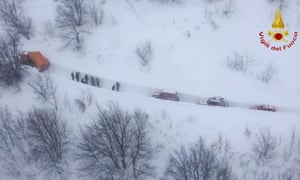Avalanche destroys Italian hotel, up to 30 feared dead under snow
Barely 24 hours earlier, the management of the hotel in the picturesque Italian ski resort of Farindola, three hours east of Rome, had tweeted: “A dream Tuesday … The snow is giving us spectacular scenery!”
But by Thursday afternoon authorities held out little hope of finding anyone left alive after an avalanche buried the four-storey building with its eight staff and 20 guests, including several children, inside.
They were reported to have assembled on the ground floor on Wednesday awaiting an evacuation after a series of earthquakes had rocked the area during the day, but it was delayed because of the bad weather. Then the avalanche hit.
Amid treacherous weather conditions, rescue workers and sniffer dogs continued their search on Thursday at the four-star Rigopiano hotel in the lower Gran Sasso mountain range of the central Abruzzo region.
Titti Postiglione, head of the department’s emergency office, said more avalanches were possible because the temperature was rising, while further quakes were also possible. “This is an enormously complex rescue operation,” she said.

Firefighters at the scene said the hotel, which stood about 1,200 metres above sea level, had been swept away and “only a little piece” remained upright.
Luca Cari, a fire service spokesman, said: “The building was basically run over by the avalanche, leaving it buried. I saw mattresses that had been dragged for hundreds of metres, which shows how big the search area is. There are tonnes of snow, tree trunks and all kinds of detritus.”
The bodies of three victims had been removed from the hotel, authorities said. Two people, both with hypothermia, survived because they were outside the building when the avalanche hit.
One was Giampaolo Parete, 38, who told doctors he had gone to collect something from the family car, leaving his wife and children, aged six and eight, inside. “I am alive because I went to get something from my car,” Parete told medical staff.
“This is a tragedy of enormous proportions,” said the Italian health minister, Beatrice Lorenzin.
Antonio Crocetta, a member of the Alpine rescue squad who was on the scene, told Reuters: “The hotel is almost completely destroyed. We’ve called out but we’ve heard no replies, no voices. We’re digging and looking for people.”
The first rescue workers reached the area by helicopter and ski in the early hours of Thursday, but it was midday before a snow plough and excavation equipment managed to pass the snow-clogged roads leading to the hotel.
Italian TV images showed piles of snow and rubble in the hotel’s foyer, while rescuers were filmed digging through a wall of snow.
A base camp for rescue workers was set up in the town of Penne, about six miles (10km) away, where ambulances waited for the road to be cleared.
Avalanche warnings were issued across the region, dominated by Gran Sasso, a majestic 2,912-metre (9,554ft) peak. The area is home to numerous small ski resorts that are popular with day-trippers from Rome and urban centres on Italy’s east coast.
Experts say the avalanche may have been triggered by the earthquakes that struck the central Italian region on Wednesday, measuring between 5.1 and 5.7 magnitude.
An 82-year-old man died after the roof of a farm building in Castel Castagna, a town in the Abruzzo province of Teramo, collapsed on him.
A mother and her child were pulled from rubble in the same area, while the search for a 60-year-old man, buried under snow in nearby Campotosto, was called off on Wednesday night. Three farmers were reported missing.
“In general, avalanches can be caused by earthquakes,” said Paolo Bazzurro, a professor of hazard and risk assessment at the University Institute for Superior Studies in Pavia, “but there is no certainty yet that this is the case”.
The civil protection agency has warned of further avalanches, with its chief saying the situation remained critical. The Italian prime minister, Paolo Gentiloni, said Italy was caught in an “unprecedented vice” of simultaneous earthquakes and heavy snows.
“Bad weather and earthquakes in the same area have made it a complicated situation,” Fabrizio Curcio said, adding that authorities were confronting “two exceptional events that already alone would have created great difficulty in the response”.
He said that when heavy snowfall was expected “we try to tell people to stay in their own homes, if they are secure, obviously. And in the areas of quakes, people should leave their homes. Putting together these two elements is extremely complicated”.
The quakes struck near Amatrice, one of the towns destroyed by an earthquake in August that left almost 300 people dead and thousands homeless. Two powerful tremors struck the area in late October, but nobody died because the inhabited areas affected had already been evacuated.
Bazzurro said there was a significant probability that the highly seismic area would be hit by more tremors.
The bell tower of the Sant’Agostino church in Amatrice, the last monument to survive last summer’s quake, collapsed after the first quake on Wednesday morning, according to local news reports.
Since the Amatrice disaster in August, there have been nine shocks measuring more than a five magnitude and a total of 47,000 registered aftershocks. Italy straddles the Eurasian and African tectonic plates, making it vulnerable to seismic activity when they move.












